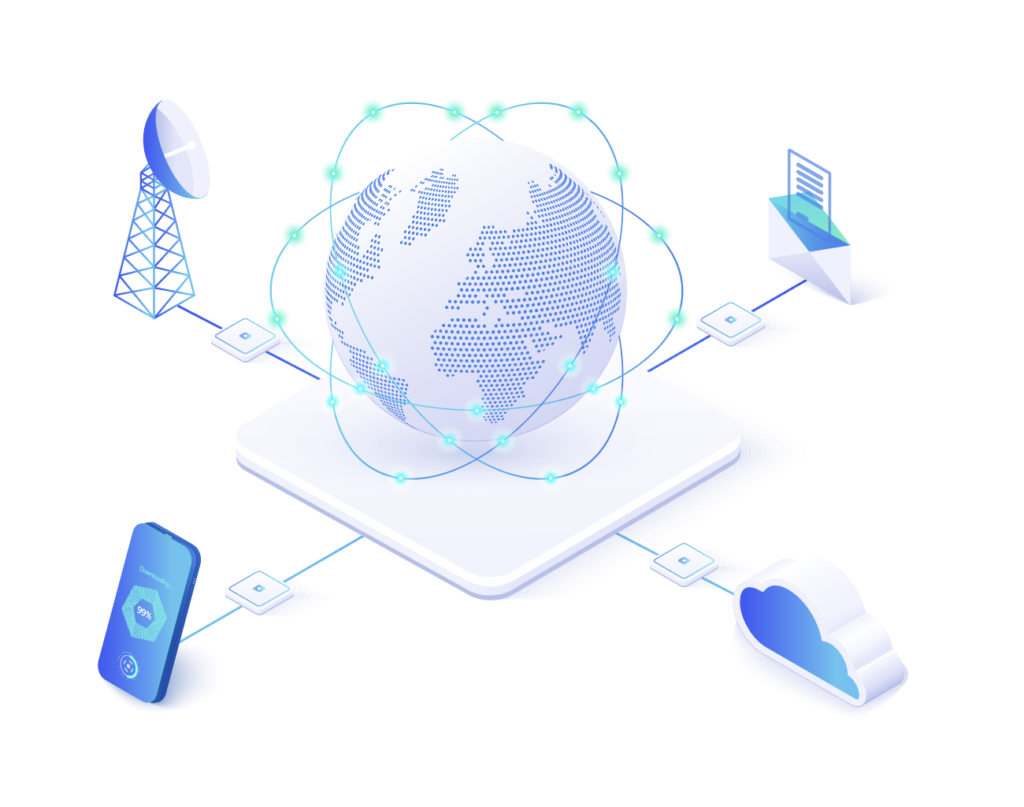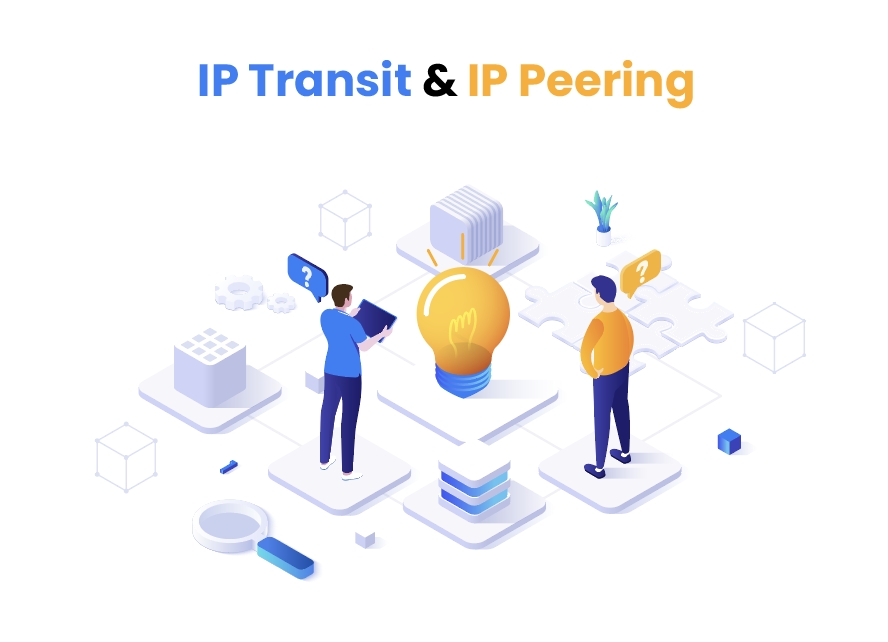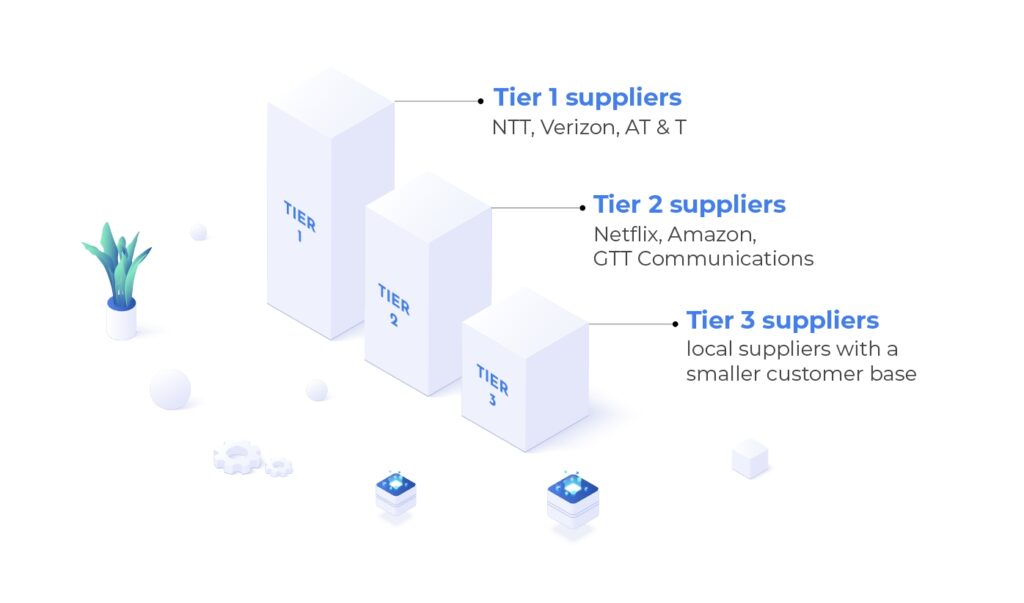6 Min Read |10 June 2024 | Key Words: IP Transit, IP Peering, ASN, BGP
What is IP Transit?
Have you ever wondered how to access any website in your browser without any issues? Websites are hosted on servers distributed across the world. Yet, you can easily access any website with little to no delays.
This article shall reveal how IP transit, an interesting internet feature, ensures a smooth browsing experience.

An Internet Protocol (IP) Address is a unique number assigned to every device on a network. It helps to identify and communicate with other devices on the internet.There are two main types of IP Addresses:
- IPv4: A 32-bit address.
- IPv6: A 128-bit address, introduced to handle the growing number of devices.
IP Addresses are grouped into blocks and given to Regional Internet Registries (RIRs). These registries then distribute the addresses to local entities like ISPs, businesses, and government agencies.
An Internet Service Provider (ISP) is a company or organization that provides services for accessing, using, or participating in the Internet. ISPs connect customers to the broader internet infrastructure, allowing them to browse websites, send emails, stream videos, and more.
IP transit is a service provided by Internet Service Providers (ISPs) that allows internet traffic to travel through their networks to reach its destination. ISPs play a crucial role in IP transit by routing the traffic from their customers to the wider internet.
IP transit and internet service providers
IP handles routing, but without BGP, this process would be inefficient, causing data to move randomly until it eventually found its destination.
Data moves across the internet in packets, each containing IP information. For these packets to reach their destination, every device or domain on the web needs an IP address, which can be either IPv4 or IPv6. These addresses help identify unique devices on the network.
ISPs are responsible for assigning IP addresses to end users, but the process starts with Regional Internet Registries (RIRs) assigning IP blocks to Local Internet Registries (LIRs), often ISPs. ISPs then assign these addresses to end users, enabling them to access the internet.
IP addressing works because each address is unique and preset. Each data packet must contain two pieces of information:
- The IP address of the sender
- The IP address of the recipient
This connection can use either IPv4 or IPv6-the longer and newer version introduced due to the shortage of IPv4 addresses.
Border Gateway Protocol (BGP): BGP is crucial for efficient data routing between different networks, known as autonomous systems. Without BGP, data would move randomly until it found its destination, making the routing process inefficient.

IP Peering vs. IP Transit:
- IP Peering: A agreement between networks to exchange traffic directly without payment.
- IP Transit: Involves paying an ISP to access the entire internet.
Understanding these differences helps in comprehending how internet connectivity and data routing work.
How IP Transit Services Work?
To send or receive data online, it must pass through various third-party networks. IP transit services handle this process, provided by Internet Service Providers (ISPs). ISP networks allow data traffic to flow through them to reach its final destination.
IP transit services are not included in basic internet access; they require a separate subscription, typically billed periodically or based on usage. Despite being a paid service, IP transit is crucial for businesses to ensure reliable data transmission. Fortunately, you can choose a service provider that best meets your needs.

Role of AS and ASN
At the core of IP transit services are Autonomous Systems (AS) and Autonomous System Numbers (ASN). An Autonomous System is a collection of IP networks and routers managed by a single organization that presents a unified routing policy to the internet. Each AS has a unique ASN used to identify it in BGP routing.
The structure of an AS allows it to manage its internal routing while interacting with other ASN for external routing. ASNs play a crucial role in the BGP routing process, helping to establish and maintain routing tables that enable efficient data packet transmission across multiple ASNs.
Role of BGP
The Border Gateway Protocol (BGP) is fundamental for enabling communication between Autonomous Systems (AS) on the internet. BGP uses an extensive routing table that acts as a database of paths to network destinations, facilitating seamless internet transit.
BGP routing is crucial when autonomous systems need to exchange routing information. Autonomous Systems announce lists of IP addresses they manage and lists of IP addresses managed by the receiving AS. These lists, known as AS routing policies, are essential for establishing connections and determining optimal data paths.
Autonomous System Numbers (ASN) are vital for BGP and internet traffic between large networks. Each AS has a unique ASN, similar to a business license number, that identifies it with other networks.
- 16-bit long and contain numbers between 1-65534 (e.g., AS55054)
- 23-bit long and contain numbers between 131072-4294967294 (e.g., AS139594)
Levels of IP Transit Providers
Levels of IP Transit Providers

IP transit providers are categorized into three tiers based on their network size, reach, and interconnectivity:
- Tier 1 Providers: The Backbone of the Internet (global network)
Tier 1 providers are the largest network operators, forming the global internet backbone. They exchange traffic with other Tier 1 providers without cost through peering agreements. They offer global reach and high capacity. Examples include Verizon and AT&T.
- Tier 2 Providers: Regional Network Operators
Tier 2 providers buy IP transit from Tier 1 providers and engage in peering with other networks. They operate regionally and offer more affordable services than Tier 1 providers. Examples include Comcast and Vodafone.
- Tier 3 Providers: Local Network Providers
Tier 3 providers purchase IP transit from Tier 1 or Tier 2 providers to deliver internet connectivity locally. They serve residential and small business customers. Local ISPs and smaller telecom companies typically fall into this category.
How to Choose the Right IP Transit Provider?
Coverage consideration
- Global Coverage: Opt for a Tier 1 provider.
- Regional/Local Coverage: Consider Tier 2 or Tier 3 providers for better cost-effectiveness.
Cost Consideration:
- Tier 1 Providers: Higher cost but offer extensive global reach.
- Tier 2 and Tier 3 Providers: More affordable and suitable for specific regions
Considering these factors will help you find the best IP transit provider for your needs
IP Transit vs. IP Peering
IP transit is a paid service where a network pays for access to the entire internet through another network’s infrastructure.In contrast, ip peering is a mutual agreement between networks to exchange traffic directly without cost, aiming to reduce latency and bandwidth charges.
Top 3 Differences Between IP Transit and Peering
Access:
- IP Transit: Provides access to the entire internet.
- Peering: Involves direct exchange between specific networks.
Cost Model:
- IP Transit: A paid service based on bandwidth or capacity.
- Peering: Generally no charge, based on a mutual agreement.
Relationship:
- IP Transit: Establishes a customer-provider relationship.
- Peering: Forms a partnership between networks of similar size or traffic volume.

It follows that IP transit provides comprehensive Internet access suitable for wide global coverage, while peer-to-peer connections provide a cost-effective, low-latency solution for direct data exchange between networks.
Conclusion
IP transit is a foundational service that ensures seamless internet connectivity and efficient data transmission across the globe. By understanding its operation, the roles of ISPs, Autonomous Systems, and BGP businesses can make informed decisions about their internet infrastructure. Whether opting for Tier 1 providers for global reach or Tier 2 and Tier 3 providers for regional needs, the right choice depends on specific connectivity requirements and budget.
Additionally, recognizing the differences between IP transit and IP peering can help optimize network performance and cost-efficiency, ultimately enhancing overall internet experience.



